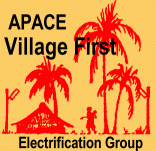|
The Story of APACE
In the first APACE Newsletter (August 1976) there is an outline of the local and international movements which were concerned with appropriate development in the newly independent Pacific nations. In Sydney at this time a "Young Nations Conference" was to be held at the University of NSW. Many people realised that large scale projects using complicated, capital intensive technology were no answer to the needs of these small nations.
A major objective of APACE was to help with appropriate development in Australia’s neighbours but it also aimed to encourage and assist the growing number of Australians who wanted more attention paid to the development of technology based on sound ecological principles and a rational and equitable use of resources.
In our second newsletter, Summer 1978, Dr Robert Waddell, one of the founders of Apace, wrote "APACE was actually born and christened in 1976 and a number of informal meetings were held in that and the early part of the following year, but the first official general meeting only took place as recently as April 30, 1977."
Bob wrote of multiple unnamed parents for the newborn organization but specified some main influences - Dr. E.F.(Small is Beautiful) Schumacher, founder of the Intermediate Technology Development Group, Tony Power,later founder of the South Pacific Appropriate Technology Foundation and George Chan,lecturer in environmental Health in Papua New Guinea.
In 1975 Bob himself had organized a course at the University of NSW in the General Studies Department, "Problems of Underdeveloped Countries". His experience with the real problems dealt with in this course and his acquaintance with supporters of the Society for Social Responsibility in Science (Dick McCann and Graham Holland among them) and with Graham Clark of Community Environment led to the idea of APACE, an organization concerned with both appropriate technology and the environment.
By 1984 there were separate branches of APACE in WA, SA and Q’land. and it had been recognized as an NGO by the Federal government through ADAB (Australian Development Assistance Bureau).Its aim remained the same - to promote general public interest in decentralised, ecologically and socially sound technology and to help third world countries in their efforts to develop along these lines.
A request for such help reached APACE through John Seed of the Rainforest Information Centre. He had been approached by a group of Solomon Islanders for help in preserving some of their rapidly disappearing forests. SI badly needed the revenue available from logging but experience had shown how great the cost and how relatively small the return from this method of exploiting a valuable resource. The people needed cash for taxes and education expenses but customary owners sought a form of development which would leave at least part of their forest intact.
The Solomons faced dozens of logging applications which, to an uninformed populace, were very appealing. In areas where logging had done its worst people were bitterly aware of their losses and it was plain to John Seed and to the many concerned Solomon Islanders he conferred with that education was the most urgent need. People needed to be informed about logging practices which provided sustained yield and environmental safeguards - practices followed in other parts of the world.
Many ideas for development compatible with environment and culture came out of these conferences too, ideas for local exploitation of timber, agricultural and fishing resources.
The importance of electricity
Although electricity provided much appreciated opportunities for the developments villagers desired - such as power for a bakery and for tools used in timber work - it was greatly valued for its contribution to village society. It made community events in the evening possible, for example, craft events and planning meetings, and most importantly it allowed homework to be done after daylight hours. Apart from the long canoe trips to and from school, children had jobs to do such as tending gardens, collecting firewood and minding their younger siblings.Electric light expanded their day just as it did for adults.
The APACE micro-hydro system at Iriri was a source of community pride, a symbol of rural enterprise and community spirit. The people had been involved in every step of the project.
|





